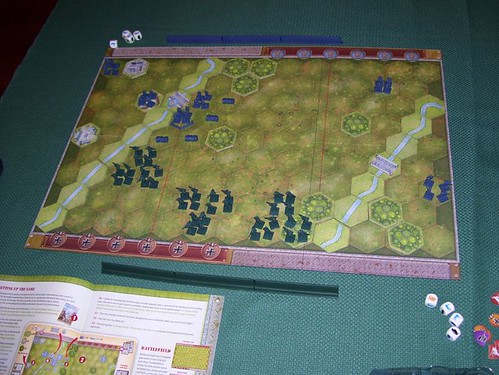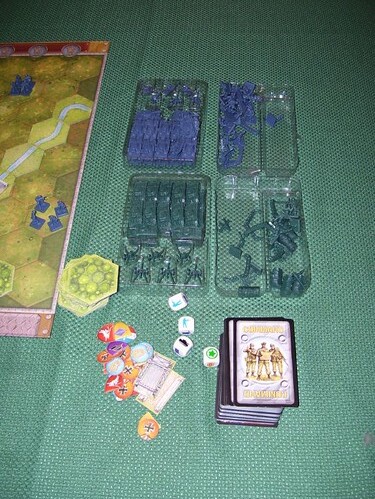Memoir ’44 – Wargaming with the wife
Mrs. G is never in the mood for anything except girly movies, cookies and Crunch bars. However, she does have very geek sensibilities. What this means is, almost every entertainment media we watch or play or whatever, has to be a surprise up to the last second, because… if she had the choice, she would never pick anything remotely cool.
So, the onus is on me to find stuff that I know she will like, even though her first instinct would be to roll her eyes and grouse about it. This can be daunting, because I’m always worried about the one time that I will make her watch something that legitimately sucks, or… that she just doesn’t like, at all.
?That said, I do have a very good track record. The only thing I can remember her really hating was “Rush Hour”, and recently, “Monster House” which we didn’t get through five minutes of, because it was “going to be ‘too scary'”. Lame.
?Anyway, I had gotten the board game Memoir ’44 from Tanga?a few weeks back. It is made by Days of Wonder?who made Ticket to Ride. I absolutely love TTR, and I have read quite a few comments by guys who said that their wives loved to play Memoir, so I had to try it out.

I must admit that as I opened the box, and started to read the rules, I was very skeptical. I can’t say I am a fan of war games, and it felt like the same old same old until I got to around page 10, where combat was explained.
?To keep things simple, I’ll explain how infantry units work. Basically, the game is played on hexes, and the combat strength of units is based on how close they are to their target. If they are adjacent to their target, they are at combat strength 3.? if there is a space between… combat strength 2, and if 2 spaces between, combat strength 1. Any more than that and they are out of range. Combat strength determines how many dice you roll.
Some of the cool bits from the game.?Note the dice:

Each die has 4 different symbols: an infantry unit, armor, a retreat flag, a grenade, or a star. If you are attacking an infantry unit, and roll an infantry unit symbol, that counts as a hit. Roll an armor, and it is a miss. The grenade symbol means a hit on?either type. The retreat flag is really nifty. For each flag you roll, the target is forced to retreat when hex in the direction of the target player’s side of the board. If the unit is unable to retreat, they take damage for each?space they can’t retreat.?(Don’t ask what the green star does, because I have no idea!)
For some reason, this mechanic really turned me on, and I?could feel the big dumb grin on my face. For me, half the fun of?a game is?feeling the?genius of the designer come through.?I was?really ready to play.
Mrs. G, on the other hand, was bloodshot from a full day at the computer screen. I was a little worried, would she make it through?
Luckily, she was playing Allies, and the?beginner scenario was Pegasus Bridge. The deck is stacked heavily?against the Germans (who she refused to play.)?
To make a long story short… she kicked my ass, and she loved it, even half asleep!
The objective of this scenario was to get 4 victory points. Killing an entire unit nets you a point (she killed?2 of mine.) Occupying a bridge gets you 1 point. There are 2 bridges on the map.
Here is her lonely one-man unit who swooped in and won the game!

Unfortunately, she was “too tired” to reverse the roles and try it again. 😉
?I expect we will play?this?a few more times, and?since it is 2-player, it is a great game for the Bunker attendee who wants to find a quiet corner in the Analog Room and play a quick round or two.

